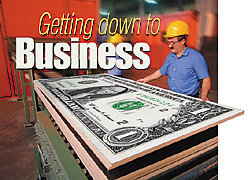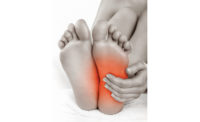
April could have been dubbed the "Business of Safety Month."
At the United Nations headquarters in New York, the Global Reporting Initiative kicked off on April 4th, with the lofty goal of "elevating sustainability reporting on environmental and social performance to a level equivalent to financial reporting."
On April 17-19, the annual conference of the Coalition for Environmentally Responsible Economies (CERES) was held in Washington.
A week earlier and just a couple of miles away, the second annual Workplace Safety Summit was hosted by Georgetown University's Center for Business and Public Policy.
More broadly, 2002 could be called, "The Year of the Business of Safety."
In February, Georgetown launched its Business and Policy Center, with the intent to educate managers about the value of safety. In March, almost 300 safety and health pros attended the "Business of Safety Symposium" sponsored by the American Society of Safety Engineers. In June, a two-day management symposium held by the American Industrial Hygiene Association focuses on "key organizational dynamics that drive performance measurement and management systems."
Later this year, ASSE will launch an "Executive Program in Safety Management" as a continuing education series of seminars. And the National Safety Council has announced a new program: "Awards for Outstanding Achievements in Safety & Productivity."
Shifting focus
focus What in the name of industrial safety and hygiene is going on? Why are business buzzwords suddenly bombarding a traditionally technical and regulatory profession? Why do one in three professionals surveyed byISHNwant to take business management courses in the near future? More than 30 percent claim to be more interested than ever in making a business case for safety and health. Why will next month's American Industrial Hygiene Conference have 18 professional development courses relating to management, and only five for regulatory issues?"Safety and health performance is a prerequisite to achieving superior business performance," explains Steve Newell of Organization Resources Counselors, which advises major corporations on safety and health issues. "Most of us believe that our efforts can be linked to better productivity, product quality, employee recruitment, retention, morale, etc., hence increased profitability. But as a profession we have yet to prove it."
Adds Mary DeVany, MS, CSP, CHMM, of DeVany Industrial Consultants: "Occupational safety and health is not a religion. It's all about dollars. Professionals may see it as fundamentally about morals and ethics, but that has no bearing in the business climate in the U.S. today."
Spirit of the times
Step back and you can see a number of trends converging to put the spotlight on the business side of safety and health:
"Costs are business motivators. Keeping employees safe and healthy saves businesses money. Managers can relate to that! As much as you and I would prefer that worker health and safety be a moral imperative that all businesses follow, sadly, that will never be the case." - a safety and health pro wishing to remain anonymous
"In business today, it is performance that counts - shareholder return, profits, growth, product penetration, market share or whatever. As my boss put it to me quite correctly, we are in the business to maintain and enhance our position as number one in our market, not to be number one in safety or environment. Environmental health and safety must contribute to market position and the bottom line, not substitute for it."
- a director of health and safety for a global consumer products corporation
Back to the future
All this talk about the business benefits of safety and health is actually old, recycled news. Back in 1926, the American Engineering Council studied 14,000 companies to see if safety and productivity efficiency were connected, and suggested that good safety is conducive to maximum operating efficiency.In 1944, R.B. Blake, the senior safety engineer for the U.S. Labor Department's Division of Labor Standards, said, "The main driving force behind the industrial safety movement is the fact that accidents are expensive. Substantial savings can be had by preventing them."
Two years later, Rollin H. Simonds, a professor of management at Michigan State's graduate school of business, developed a method for determining accident costs with the backing of ASSE, the National Safety Council, and 45 industry groups. In 1951, "Estimating Industrial Accident Costs" was published by Simonds in the Harvard Business Review.
So why, more than a half-century later, is the old idea that "safety pays" such hot stuff? Why is ASSE holding its first business symposium now, while participants of the Workplace Safety Summit try to find CEOs to step up and make public service announcements promoting the value of safety like it's ground-breaking stuff?
Part of it is timing. OSHA and the regulatory age came along in 1970 and dominated industry's safety agenda for at least the next 20 years. Many companies still take safety only as far as OSHA's rules require. And across the board, whenever OSHA stirs - witness the recent recordkeeping policy changes and the battle over ergonomics - safety and health pros pretty much drop what they're doing to decipher requirements and meet compliance deadlines.
Another reason is the age-old "money-versus-the-mission" debate. One side says safety is a moral imperative owed to employees, a right that warrants no justification in dollars and cents. Richard F. Boggs, a former vice president of Organization Resources Counselors, articulated the other view in a speech at the 1988 American Industrial Hygiene Conference: "We can no longer justify (our) programs simply because 'they are good for the company' or because 'it's the correct thing to do.' We must show our senior management that the programs are cost-effective and make good business sense."
A number of safety and health pros sit on the fence in the middle of this debate. "We fear that talking money will hurt our image as a humane and regulatory-driven necessity to the company," writes Allan T. Goldberg of International Risk Control America, in a paper for ASSE's business symposium.
There's fear that companies will shift focus from human life and employee well-being to dollars and cents, explains Steve Newell of Organization Resources Counselors. He adds another concern: that safety and health isn't a real money-maker.
Goldberg calls the debate a false dilemma, arguing that "it does nothing to diminish the importance of human cost to add preserving a company's bottom line as a driver of safety requirements."
Newell is even more forceful: "The business case analysis is critically needed to shift the perception of safety and health in some companies. Safety and health efforts are viewed in some companies as a cost of doing business and investment in those situations is often limited to ensuring regulatory compliance, or it is gratuitous."
Need for tools
But making the case requires two catalysts that have historically powered every movement forward in workplace safety - champions and tools. Dr. Alice Hamilton knocked down industry doors to spread the word about the dangers of lead poisoning and other toxic exposures in the early 1900s. OSHA's regulations, however maddening to interpret, have been implementation tools. Behavior-based safety's boom in the 1990s was driven by champions - popular speakers and authors like Scott Geller, Aubrey Daniels and Tom Krause - and tools like easy-to-use observation checklists.Right now, most pros don't have the tools to quantify the value that safety and health adds to the business, says Newell. Overworked and understaffed, many don't have the time - or the access - to financial and other business data that sits in accounting, personnel and operations departments across organizations.
"The trouble with safety is getting the hard documentation of how it helps the bottom line," says P.D. Shabay, vice president of human resources for Bell Helicopter/Textron.
"There's a lot of soft fluff about the return on safety," says one safety and health pro.
But help is on the way. ORC plans to publish a book on safety and health performance metrics to help state the business case. Integrated, enterprise-wise computer networks should make it easier to pull data together. Educators are slowly but surely adding business elements to safety and health undergraduate and graduate degree programs. And some formulas and calculations already exist - see Dr. Richard Fulwiler's article in the May issue of ISHN, p.28, as well as the "Your Turn" column, p.74. Check out the sidebars (below) to this article for more ideas.
As for champions, OSHA chief John Henshaw says: "We can't be afraid to promote the value of safety and health. OSHA can help develop the business case for safety in schools and organizations. There's the perception that OSHA is only about standards and enforcement. We have got a lot of experience on how safety helps the bottom line."
Champions and calculations aside, the strongest force behind the burgeoning interest in safety's business benefits comes straight from Maslow's hierarchy of needs. "Everyone is just trying to survive," says one safety and health manager. "If my company survives, I have a job and I survive. It all boils down to dollars and cents, the need to provide shareholder value and survival."
SIDEBAR 1: Ask for forgiveness
Ten commandments for savvy pros:1 Come to work each day willing to be fired. 2 Circumvent orders aimed at stopping your dream. 3 Do any job needed to make your project work. 4 Network. 5 Build a spirited team. 6 Work underground. 7 Be loyal and truthful to sponsors. 8 Ask for forgiveness rather than permission. 9 Be true to your goals. 10 Keep the vision strong.
- Ron Kitson, CSP, safety and health director, Corning, Inc.
SIDEBAR 2: Can you connect?
Can you prove how your safety and health efforts contribute to:
- Sales growth
- Image
- Product innovation
- Product differentiation
- Customer service
- Time to market
- Cost control
- Product quality
- Ron Kitson, CSP
SIDEBAR 3: What managers want
How well do you measure up to what corner office types expect from safety and health pros (in organizations truly committed to safety and health)?
- Dedication & passion
- Trust & integrity
- Formal education & certification - shows discipline and drive
- Professionalism
- Technical expertise
- Risk assessments - knowing and prioritizing liabilities
- Leadership, especially in times of crisis
- Solutions
- Flexibility
- Forecasts - alerts & warnings on emerging issues and their impact on the company
- Measures of cost and performance
- Regulatory knowledge - interpretations and applications
- Finger on the pulse - knowing what other companies are doing to succeed in safety
- Accurate reports
- Timely delivery of services
- Minimal jargon
- Emphasis on hard data and documentation
- Ability to get to the punch line
- Homework & research
- Knowledge of business objectives
- Knowledge of ongoing safety & health activities
- Consistency - in how policies are applied (recognition, discipline, etc.)
- Communication skills - ability to get your point across to everyone
- Empathy - ability to reach into the hearts and minds of employees
SIDEBAR 4: Safety selling points
You can emphasize negative outcomes:
- Fatalities
- OSHA injury / illness rates
- Workers' comp data
- Production downtime
- Litigation expenses
- Labor replacement
- Property loss
- Regulatory fines & penalties
- Absenteeism
or accentuate the positive:
- Improved employee perceptions, morale
- Improved productivity
- Improved product quality
- Better employee retention, recruiting
- Improved customer perception/satisfaction
- Steve Newell, Organization Resources Counselors
SIDEBAR 5: Pushing the buttons
You need to know what makes your organization tick. Then match safety and health benefits to management's hot buttons. These can include:
- Cost savings
- Peer pressure
- Industry benchmarks
- Company reputation
- Fear of risk
- Reliability and consistency
- Product quality
- Productivity
- Community relations
- Brand image
SIDEBAR 6: Calculating the costs
According to OSHA estimates:
- Each avoided occupational fatality saves $910,000
- Each prevented injury or illness resulting in time away from work saves $28,000
- Each serious injury or illness avoided saves $7,000
Source: OSHA e-compliance assistance tools
